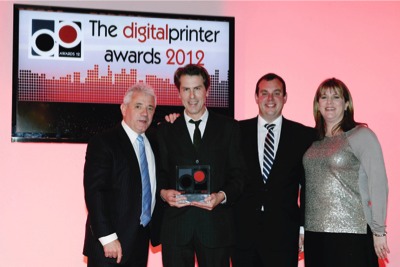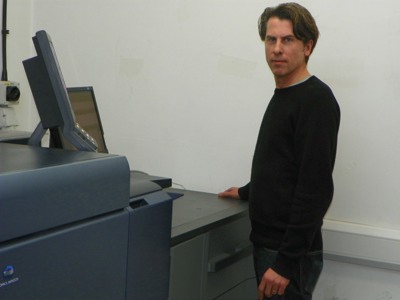Calverts Co-operative is a printing company where everyone is the boss and everyone has an equal stake. It’s also producing some nice digital print, writes Andy Knaggs.
Things have moved in Calverts Co-operative’s direction over the years. Whereas once, ideas of social responsibility – from equal pay to protecting the environment – might have been seen as the preserve of the ‘loony left’, these days they are much more likely to be commonly accepted. Calverts’ status as a ‘worker co-operative’, where all 12 staff members have an equal stake in the business and are remunerated accordingly, gives it an attractive point of differentiation when competing for print work from organisations that like the idea of an ethical print supplier.
‘We still attract left of centre organisations, but the socially aware agenda has come into the mainstream, particularly with environmental awareness,’ explained sales and marketing director Arthur Stitt, who has been with the Bethnal Green-based company since 1995, after training as a printer in Belfast. ‘It is not sandal-wearing lefties these days, it is policy. The pre-requisite for us is still to make a profit – we are not a non-profit organisation. But we have no shareholders, so all the profit stays in the company for investment.’
Even the origin of the company’s name makes Calverts stand out. It began in 1977, from the ruins of the in-house print shop at the Institute of Research & Art. The printers were quite politically active, and decided not only to set up as a worker co-operative, but also to name their new venture in honour of the English Civil War anti-royalist printer Giles Calvert. In fact, the full legal name is Calverts North Star Press – the favoured local pub also got a nod back in the late 1970s. The business model was one member, one vote, and equal pay for all, and it remains so to this day.
Working for Calverts calls for a different mindset to virtually every other print company in the country. Decisions regarding the firm’s strategy and investments are made collectively. There is no ‘them and us’ dynamic between staff and management. People have to take responsibility, because they are all directors.
‘Equal pay is a great leveller when it comes to making business decisions,’ said Mr Stitt. ‘You have to have expertise in your core role when you come here, but people progress and get involved in business strategy and it encourages them to voice their opinion. It kind of refutes that idea that money is all that motivates people. It’s not always the case. Money can sometimes blind people to what you are trying to do collectively. When we do well, everyone gets a pay rise; when we do badly, we all get a pay cut. We have never made any compulsory redundancies here.’
He went on: ‘We are all managers and directors. We have a finance director and a production director, the same as any other print business, but it is also a directorial role for the company. When you come into the business and your only other experience elsewhere is as an employee, and then here you have to think beyond your own requirements and see the bigger picture, that can be quite a big mind shift.’
Winning ways
Calverts runs both litho and digital – the digital presses being a Konica Minolta bizhub 8000 and a bizhub 6000, chosen for quality, flexibility and sustainability of performance. Last year the firm was successful in the Digital Printer awards, when its entry for fashion label The Outnet (called the Iris and Ink Look Book) won in the Marketing Collateral category. It was a surprise to win – Calverts’ last award win was in 2001. Mr Stitt explains that the company had been producing some nice work on the Konica Minoltas and decided to give it a go. The winning piece contains a mix of substrates, including transparent papers, which presented a challenge in binding, although there was no direct registration with the pages below the transparent sheets to consider. ‘The customer was happy, and that is the main thing,’ he said.
Many of the customers are in the art space – local galleries and artists wanting books of their work printed – as well as charities, educational and other public sector institutions. When responding to tenders from corporate organisations, Calverts will slant its pitch in a particular direction.
Mr Stitt explained: ‘There has been a rise in the social enterprise in the last decade. More and more procurement people have become aware of that. A social enterprise needs to produce a profit but have some measurable social value. We fall within that. If I’m talking to a big corporate, I will emphasise us as a social enterprise, rather than as a co-operative, although they are more or less the same thing. If I’m talking to a charity, I will emphasise that we hold the company in trust for the next people that come through, that we have something in common in that regard.’
Much of the work is quite bespoke, and therefore Calverts has not so far implemented a web to print system. Artists can be very demanding and particular about what they want, and the nature of these jobs lends itself much better to sitting down with a customer and discussing things in far greater detail than web to print, or even a telephone call, allows. ‘You can see, smell and touch and have a one to one with someone, rather than getting a faceless click through a website,’ he said. ‘It’s difficult to talk about paper and colours and ink over the phone.’
The company has been impressed with the quality of print possible on the Konica Minolta presses, having chosen the systems for their versatility, ability to run recycled papers, and environmentally friendly inks. The environment is an important aspect of Calverts’ approach, and it already holds ISO 14001 and FSC certifications.

For the future, the company is considering upgrading its digital technology at some point, with Landa and new larger format digital presses being of interest. The art space work tends to work better on paper than online, so Calverts sees this type of print work having longevity. However, it is looking into cross media as an extension to its service – in particular, moving beyond QR codes to embedding digital links into printed information.
‘We have got a few ideas for using this creatively,’ Mr Stitt continued. ‘With a lot of print stuff, when it wants to tell a story and you can continue that story beyond the physical object into digital media, that’s a really interesting area. The interaction of cross media gives it another dimension.’ The company is also active in social media channels through Twitter and Facebook, and regularly refreshes its website with well-written content and images that illustrate what it is capable of. The benefits of this have been clear in Google rankings.
‘Our website is like a blog. There is a lot on there and lots of people come to us through it. We did one article on food-safe inks and we now come top in a Google search for that term. We want our content to read well; it’s not just putting keywords in again and again. We have been doing this for years, so we come quite high on niche things like postcard books and look books.’





